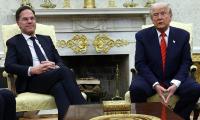The global economy is poised to generate an impressive $102 trillion in goods and services. Concurrently, worldwide military spending stands at $2,240 billion, representing 2.2 percent of the global GDP. Looking specifically at Pakistan, the country is projected to produce goods and services worth $371 billion. Notably, the recently unveiled Budget 2023-24 has allocated $6.3 billion for defense, which accounts for 1.7 percent of Pakistan's GDP. It is worth mentioning that Pakistan's defense expenditure is 22 percent lower than the global average.
Leading the pack in defense spending is Oman, allocating 8.8 percent of its GDP, followed closely by Saudi Arabia at 8.5 percent. Not far behind are Israel at 5.3 percent, Russia at 3.9 percent, the US at 3.4 percent, and India at 2.4 percent. Notably, the US stands out, having spent a staggering $877 billion on defense, accounting for nearly 40 percent of the global total defense expenditure. Furthermore, India has demonstrated its significant commitment by allocating a colossal $81 billion towards defense, solidifying its position as the fourth-largest defense spender in the world.
During the 1960s, Pakistan's defense expenditure accounted for 5.5 percent of its GDP. In the 1970s, the defense budget peaked at 6.5 percent of GDP. However, since then, there has been a gradual decline in defense spending. The recently announced budget for 2023-24 unveils a 2 significant dip, driving defense expenditure to a low of 1.7 percent of GDP, its lowest level in decades, sparking discussions on the country's changing priorities and potential implications.
A closer look at defense spending reveals that over 4-dozen countries allocate a higher percentage of their GDP towards defense compared to Pakistan. This includes nations such as India, Egypt, Sri Lanka, the United States, the United Kingdom, South Korea, France, Eritrea, Oman, Saudi Arabia, Israel, Jordan, Liberia, Brunei, Syria, Kuwait, Yemen, Angola, Singapore, Greece, Iran, Bahrain, Djibouti, Morocco, Chile, Lebanon, Russia, Colombia, Zimbabwe, Turkey, Georgia, Guinea-Bissau, Ethiopia, Namibia, Guinea, Turkmenistan, Kyrgyzstan, Algeria, Serbia and Montenegro, Armenia, Botswana, Ukraine, Uganda, Ecuador, Bulgaria, Lesotho, and Sudan. These countries exhibit a greater commitment in terms of defense expenditure relative to their GDP when compared to Pakistan.
In 2015, Pakistan's defense allocation accounted for 17.5 percent of the total outlay, indicating a low budgetary priority for this sector. This percentage reached its peak at 19.5 percent in 2017, reflecting a temporary increase. However, in recent years, the defense allocation has been steadily declining, reaching 12.5 percent of the budget under the Budget 2023-24, marking the lowest level in a decade. This downward trend indicates a clear shift in budgetary priorities.
Last year, the Pakistan Army, anticipating budgetary constraints, initiated a comprehensive 'Austerity Plan' aimed at reducing expenditures across various fronts. The Army has made significant progress in this endeavor, achieving a substantial 35 percent reduction in expenses on petroleum products. Additionally, utility costs have been curtailed by 20 percent, the procurement budget has been trimmed by 30 percent, the condemnation period for army kits has been extended, and aviation flights have been limited to critical operational needs. These measures reflect the Army's commitment to financial prudence and effective resource management.
In 2015, Pakistan's defense budget amounted to $7.6 billion. The budget reached its peak at $10.2 billion in 2018, indicating a temporary surge in defense spending. However, since then, there has been a consistent decline in allocation. The recently unveiled Budget 2023-24 allocates a mere $6.3 billion for defense, the lowest funding level in a decade. This has raised concerns about the potential impact on the country's military capabilities and strategic priorities, with the falling value of the rupee against the dollar exacerbating the situation.
India, Pakistan’s military rival, has allocated a substantial $19.64 billion for the procurement of new weapons and platforms, indicating a focused effort to modernize its military capabilities. However, despite an annual budget of $81 billion, the Indian Armed Forces face significant challenges. Obsolete equipment, inadequate ammunition, and heavy reliance on foreign imports pose serious hurdles. In a leaked letter from the country's army chief a few years ago, alarming concerns were raised. The letter highlighted deficiencies in India's tank fleet, air defenses, elite forces, infantry, and special forces, calling attention to critical ammunition shortages and obsolete defense systems. Additionally, recent revelations of corruption and internal discipline issues have further added to the concerns surrounding India's military preparedness. Over the past six years, India has jacked up its defense budget by more than 35 percent in dollars terms while Pakistan’s defense budget has come down from $10.2 billion to $6.3 billion.
It is worth noting that the defense allocation in Budget 2023-24 has experienced a nominal rise, increasing from Rs1,563 billion in the previous year to Rs1,804 billion. This nominal increase of 15 percent has taken place when the rate of inflation stands at 37.97 percent.
When it comes to the size of Pakistan’s military, the facts may surprise you. Pakistan, in terms of military personnel per capita, falls behind at least 64 other countries. Some of these countries include Turkey, Iran, Iraq, Switzerland, Italy, Norway, Singapore, South Korea, Russia, Sri Lanka, Egypt, Libya, Kuwait, Thailand, Saudi Arabia, Qatar, UAE, Israel, Estonia, Vietnam, Slovenia, Botswana, Mongolia, Yemen, Kazakhstan, Cuba, Mauritania, Croatia, Chile, Somalia, Albania, Sao Tome and Principe, Namibia, Angola, Cambodia, Uruguay, Bolivia, Romania, Morocco, Lithuania, Portugal, Burma, Algeria, Azerbaijan, Bhutan, Burundi, Bulgaria, Columbia, Serbia and Montenegro, Cyprus, Greece, Armenia, Djibouti, Maldives, Oman, Belarus, Jordan, in USD ($) terms 4.53 percent 38 percent 1,045 Inflation percent in PKR terms 6 Syria, Laos, Bahrain, Brunei, Eritrea, and North Korea. It's clear that Pakistan's military, though significant, does not rank among the largest on a per capita basis.
Defense experts consider ‘expense per soldier’ as a good measure of a military's efficiency. It reflects the cost incurred to maintain and support each soldier in a military force. A lower expense per soldier suggests a more cost-effective utilization of resources and potentially better efficiency in military operations. It indicates that a military is able to achieve its objectives while optimizing its budgetary allocation.
When it comes to "annual expenditure per soldier," the United States surpasses all other countries, allocating a staggering $577,000 per soldier. In contrast, Pakistan spends a modest $17,000 per soldier, yet its military maintains an impressive position as the 7th most powerful globally, according to the Global Firepower Index. Remarkably, the Pakistan Army, with its economical expenditure per soldier, effectively nurtures high morale and fosters a strong sense of camaraderie among personnel. This, coupled with adequate training and preparation, is instrumental in ensuring personnel are well-equipped for their roles and responsibilities. The military also exhibits efficient logistical and supply chain management, ensuring resources are readily available when needed. Following the United States, other notable countries include Saudi Arabia, Israel, India, and Iran, with respective expenditures of $247,000, $118,000, $53,000, and $41,000 per soldier.
This implies that Pakistan's military stands out as one of the most cost-effective forces globally. It demonstrates the military's ability to efficiently utilize its allocated resources while effectively accomplishing its objectives. By optimizing its budgetary allocation, Pakistan's military has showcased its proficiency in achieving desired outcomes within financial constraints, a commendable feat in today's complex geopolitical landscape.
Intriguingly, in recent decades, the Pakistan Army has cultivated a fascinating ecosystem that warrants attention. As an example, consider the financial dynamics: in the previous year, the army received an allocation of Rs724 billion from the national treasury, constituting its share of the overall defense budget. In a display of reciprocity of sorts, Fauji Foundation contributed Rs175 billion back into the treasury, alongside an ‘in-kind’ contribution equivalent of Rs40 billion through the operation of 142 educational institutions and another ‘in-kind’ Rs40 billion through the management of 143 healthcare facilities. This cumulative amount finding its way back into the treasury totals Rs285 billion. Furthermore, an additional Rs10 billion in income tax was deposited into the treasury, while approximately Rs16 billion was disbursed to support the livelihoods of more than 90,000 civilian employees. Notably, the National Logistic Cell (NLC), the Frontier Works Organisation (FWO), and Army Welfare Trust (AWT) made significant contributions as well, depositing Rs127 billion back into the treasury. Against the defense budget of Rs724 billion, approximately Rs412 billion were deposited back in the treasury.
When examining defense budgets on a per capita basis, Pakistan's expenditure emerges as strikingly modest in the global context. In stark contrast, Qatar allocates an astounding $3,955 per capita, cementing its position as the highest spender in this category. Trailing closely behind are Israel, investing $2,769, and the United States, with a substantial allocation of $2,405 per capita. In comparison, Pakistan dedicates a mere $26 per capita to defense, while its neighboring counterpart, India, spends $60 on the same basis. This stark contrast in spending patterns highlights Pakistan's commendable ability to effectively manage its limited resources within the realm of national security. The modest per capita expenditure demonstrates the Pakistani military's commitment to optimizing its resources and striving for efficient defense strategies.
Pakistan's defense budget, though modest per capita, is carefully managed to meet the country's security needs, taking into account various factors such as internal security challenges, regional dynamics, and economic considerations. It underscores the importance of prudent resource allocation and effective utilization to ensure the nation's security while also addressing other pressing socioeconomic needs.
Stephen Cohen, a highly respected scholar in foreign policy studies and a senior fellow at the Brookings Institution, as well as an emeritus professor at the University of Illinois, made a noteworthy observation regarding the Pakistan Army. In his astute analysis, Cohen highlighted that while some armies primarily focus on safeguarding national borders, and others prioritize protecting their own position within society, the Pakistan Army uniquely encompasses all three objectives. It not only assumes the critical responsibility of defending the nation's borders but also plays a significant role in shaping and safeguarding its own role within the Pakistani society. Furthermore, the Pakistan Army has consistently defended causes and ideas that it deems crucial to the country's interests. This multifaceted role underscores the complexity and significance of the Pakistan Army's mission, as it operates in a dynamic environment that demands a comprehensive approach to national defense, internal stability, and the promotion of specific causes and ideas.
Dr. George Friedman, a renowned American strategist and geopolitical forecaster, shed light on the stability of Pakistan and the vital role played by its united and loyal army. According to Dr. Friedman, as long as the Pakistan army remains steadfast in its commitment to the concept of a unified Pakistan, the centrifugal forces that could potentially rip the country apart will be effectively neutralized. Dr. Friedman's insights offer a valuable perspective on the complex dynamics shaping Pakistan's trajectory, emphasizing the significance of a strong and united military in safeguarding the nation's cohesion and stability.
In the Pakistani context, the current state of the defense budget paints a worrisome picture. The budget allocation for defense has hit historical lows, both as a percentage of GDP and as a proportion of the overall budgetary outlay. This places Pakistan's defense spending significantly below the global average.
Furthermore, the defense budget, even in dollar terms, has reached an unprecedented low, reflecting a troubling decline in resources dedicated to ensuring the nation's security. These indicators serve as a stark reminder of the urgent need for a careful evaluation and thoughtful consideration of Pakistan's strategic priorities.
In an ever-evolving global landscape, where geopolitical dynamics and emerging threats constantly reshape the security environment, Pakistan cannot afford to overlook the implications of its defense budget decisions. It is essential for policymakers to assess the potential consequences for national security and the well-being of its citizens.
While it is imperative to acknowledge fiscal constraints and prioritize economic development, maintaining a robust defense apparatus is vital for safeguarding Pakistan's 9 territorial integrity and protecting its people. Striking the right balance between economic progress and national security is a complex challenge that requires prudent decision-making and long-term vision.
Ultimately, the defense budget is a reflection of a nation's commitment to its security and the well-being of its people. It is essential for Pakistan to undertake the necessary steps to ensure that its defense capabilities align with the demands of the present and future, securing a prosperous and stable future for the nation and its citizens.
A security personnel standing outside a Soneri Bank branch in this image released on July 13, 2022. —...
A woman picks a gold earring at a jewellery shop in the old quarters of Delhi, India, May 24, 2023. —...
A representational image showing a person using a mobile phone as shades of coding appear of the left side. —...
US President Donald Trump holds an executive order about tariffs increase, flanked by US Commerce Secretary Howard...
In this photo illustration a Binance logo is seen displayed with crypto coins in the foreground. — APP/FileDUBAI:...
Chinese and US flags flutter outside a company building in Shanghai, China April 14, 2021. — ReutersBEIJING: China...







